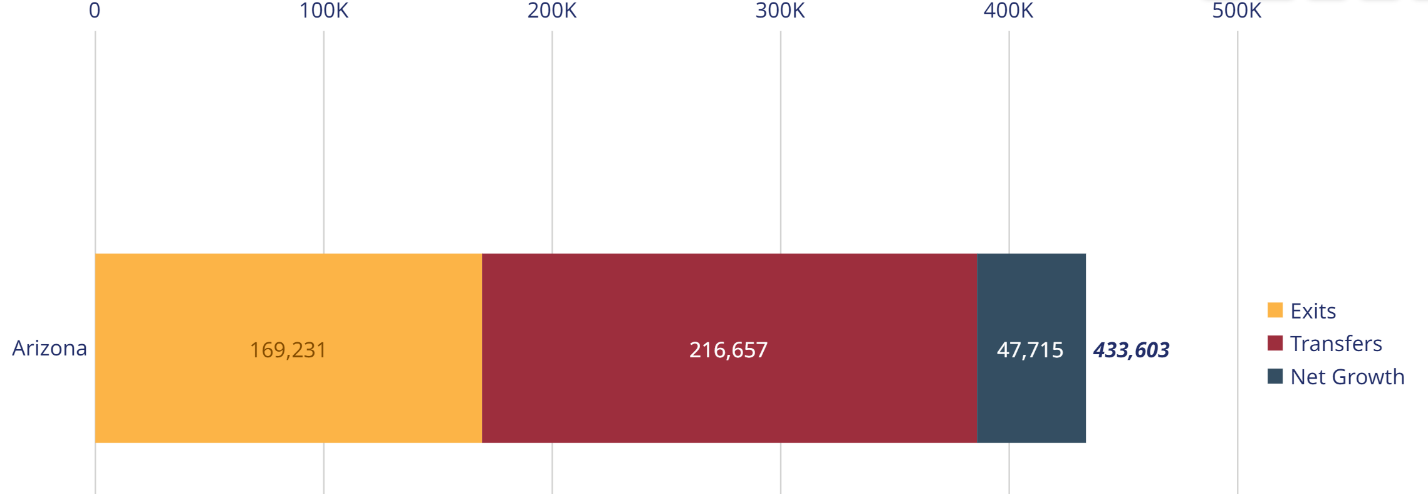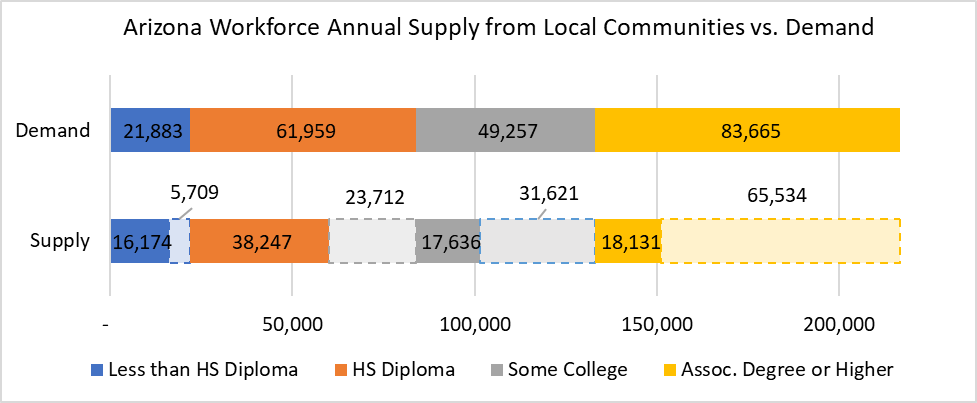Arizona’s Future Workforce Relies on Improvements to Post-Secondary Outcomes for Arizona Students

According to the Arizona Office of Economic Opportunity, between now and 2032, 430,000 jobs will open each year across Arizona’s economy. Of these, workers transferring from one job to another will fill about 217,000 jobs. People exiting the workforce will fill another 170,000 openings. Lastly, economic growth will create 48,000 openings, as shown in Figure 1. The 217,000 transfers will remain in the workforce, moving their skills and credentials to new jobs, but the exits and net growth of new jobs will require new skilled workers. How will our state fill those jobs? Will employers be able to tap Arizona’s young talent for the massive number of skilled workers needed?

Figure 1: Arizona Office of Economic Opportunity (AOEO) data indicate that statewide, there will be approximately 433,000 job openings each year until 2032.
Arizona’s education system is tasked with answering those questions. The state needs to prepare our youth to fill these jobs by ensuring that students have the skills necessary to participate in the economy. So, let's compare the Employment Demand, the employment needs of Arizona’s future economy, with the Employment Supply, the educational attainment of the population, to explore where action is needed to ensure we have the workforce necessary to adequately fill employment needs.
Employment Supply
Recently, 90,000 high school seniors enroll in Arizona each year. Of that group, approximately 16,000 do not graduate, 38,000 receive a diploma but do not attend college, 18,000 attend college or pursue a professional certificate but do not complete, and 18,000 receive an Associate, Bachelor’s, or higher degree from a college or university within 6 years of gaining their high school diploma, as shown in Figure 2.

Figure 2: Approximate outcomes from recent Arizona high school seniors six years after graduation (Arizona Board of Regents, Arizona Department of Education).
Employment Shortfall
With these education attainment outcomes in mind, we can identify the shortfalls of each category by looking at the types of credentials needed to fill projected employment demand, assuming these jobs will require similar skillsets. (Bureau of Labor Statistics Occupational Employment and Wage Statistics)
When comparing the credentials of Arizona students with the projected workforce demand of about 218,000 annual exits and new openings, we can see a significant gap in filling Arizona’s job openings with roughly only 90,000 high school seniors. As shown in Figure 3, annual job openings require about 6,000 more workers with less than a high school education, 4,000 more with only a high school diploma, 32,000 more with some college or a professional certificate, and 65,000 more with at least an Associate’s Degree.

Figure 3: Occupation Demand: Arizona OEO 2023-2032 Occupation Projections (Exits and Growth Only) and BLS Occupational Statistics OEWS matching each occupation with educational attainment of those currently holding each position (2023 series).
Using this analysis, we can see that Arizona will need to import about 130,000 new workers annually to fill projected exits and new growth in job positions if attainment outcomes are not improved. This critical need is most pronounced in positions requiring an Associate’s Degree or above, where about 18,000 of these credentials are obtained each year to fill about 84,000 openings.
Importing the difference of about 65,000 workers with this level of educational attainment is no small challenge, especially considering the recent lack of affordable housing and the national narrative of extreme heat and water concerns affecting our state. Additionally, Arizona’s wages are not always competitive for in-demand careers like teachers and nurses.
Moving Arizona Forward
An expanded focus on realizing The Arizona We Want, including advancing Arizonans’ seven Shared Public Values, can support the attraction and retention of a qualified workforce. The Arizona Education Progress Meters measure how the state is doing on key metrics from early childhood education through college and career. These key indicators, including lows in early indicators like Third Grade Reading and lows in later indicators like One Year College Going, should guide leaders’ renewed and expanded focus on improving our state’s education outcomes.
CFA’s constant engagement within communities across Arizona has consistently revealed that Arizonans want a future with those improved educational outcomes for our students. Our most recent Arizona Voters’ Agenda findings indicate that 85 percent of likely voters believe we should increase the number of students who pursue education or training beyond high school. Other findings include:
Dig Deeper – Analyze Data to Support Investment and Action
Data are available for all Arizona public and charter schools, districts, cities, and counties. As well as, the state as a whole.
Contact our team if you have questions or need assistance with the data tools.
About Our Data Sources
As with all the Arizona Progress Meters, data are publicly available from a trusted and regularly updated source. Data used in the education metrics come from the Arizona Department of Education, the U.S. Census Bureau, the Arizona Board of Regents, and the U.S. Student Clearinghouse. For more information, see our full methodology.
About Arizona Progress Meters
CFA developed the Arizona Progress Meters as a tool for policymakers, business leaders, civic leaders, educators, and others across the state to understand how Arizona is doing in areas critical to achieving The Arizona We Want. Eight Arizona Progress Meters provide valuable and regularly updated data on 80+ metrics in education, jobs, healthcare, environment, civic engagement, infrastructure, and more to support policymakers and other leaders’ data-driven dialogue, decision-making, and action. Learn more and leverage all the Arizona Progress Meters today.
The Arizona Education Progress Meter was co-developed by Education Forward Arizona and Center for the Future of Arizona in 2016, with the goals set in 2017. The Arizona Education Progress Meter is one of eight Arizona Progress Meters created by the Center for the Future of Arizona.
